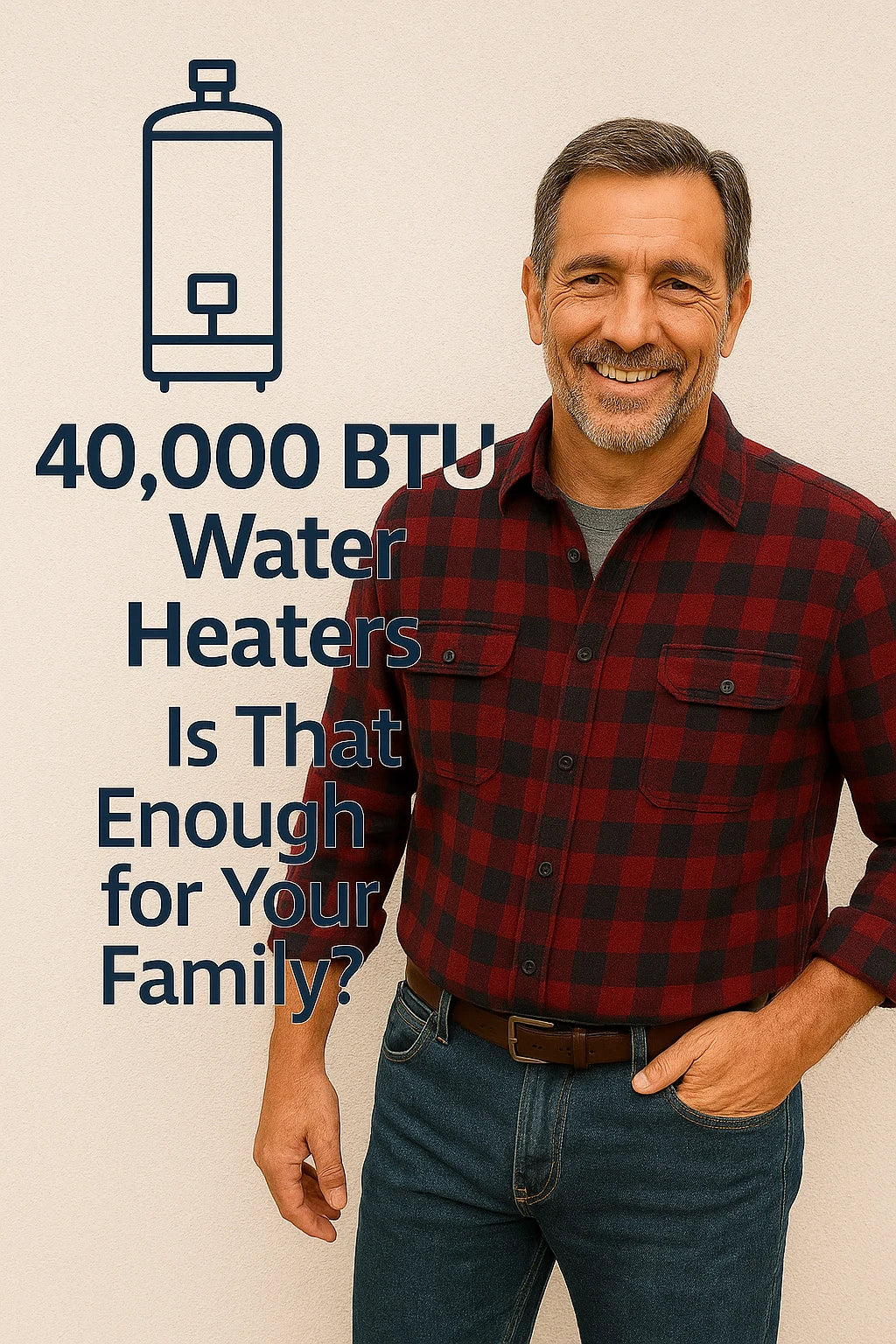When you're evaluating gas water heaters, BTU (British Thermal Unit) input is one of the most important specs to understand. As Mike Sanders, I’ve seen many homeowners focus solely on tank size, but overlook the equally critical burner capacity. Today we’ll unpack everything you need to know about 40,000 BTU gas water heaters in 2025 and whether they can handle your household’s hot water needs.
🔢 What Does 40,000 BTU Mean?
BTU measures how much heat energy the burner generates to heat the water in your tank:
-
40,000 BTU/hr = 40,000 British Thermal Units per hour
-
It describes the maximum heat input the burner can deliver
-
More BTUs = faster recovery (heating cold water back to set temperature)
The State ProLine Atmospheric Vent 50-Gallon 40,000 BTU Water Heater is a classic example of a model that balances moderate BTU output with excellent performance for many families.
🏡 How Burner Size Impacts Recovery Rate
The bigger the burner, the faster your tank refills with hot water after usage:
-
A 40,000 BTU unit can recover approximately 40-50 gallons per hour depending on your incoming water temperature.
-
For comparison:
-
30,000 BTU model: ~30-35 gallons/hr recovery
-
50,000 BTU model: ~55-60 gallons/hr recovery
-
In practical terms:
-
40,000 BTU allows two back-to-back showers comfortably for most households.
-
It keeps up with typical laundry and dishwashing cycles without issue.
📈 First Hour Rating (FHR) for 40,000 BTU Models
The First Hour Rating combines stored hot water with recovery over the first hour of peak demand:
| Tank Size | Burner Size | Typical FHR |
|---|---|---|
| 50 gal | 40,000 BTU | 80-90 gallons |
| 40 gal | 40,000 BTU | 70-80 gallons |
This means a 50-gallon, 40,000 BTU model offers enough hot water for several consecutive showers, laundry loads, and dishwasher cycles during busy mornings.
🌡️ Is 40,000 BTU Enough for Your Family?
Perfect for:
-
Households of 3-5 people
-
Homes with 1-2 bathrooms
-
Moderate simultaneous usage
-
Existing atmospheric vent systems
May fall short for:
-
Families with 6+ members
-
Luxury bathrooms (multiple showerheads, large soaker tubs)
-
Multiple simultaneous showers every morning
-
High demand situations with no staggered usage
In high-demand homes, a higher BTU burner or tankless system may be more suitable.
🏠 Real-World Scenarios
Example 1: Suburban Family of 4
-
Two showers in the morning
-
Dishwasher and laundry run in the evening
-
Result: 50-gallon 40,000 BTU performs perfectly
Example 2: Family of 5 with Teenagers
-
Three consecutive showers in the morning
-
Laundry and dishwasher often overlap
-
Result: May experience occasional shortfalls unless usage is staggered
Example 3: Empty Nesters
-
Low daily hot water needs
-
Result: 40,000 BTU more than sufficient
🔧 Why Not Always Go Higher?
While bigger burners recover faster, they aren’t always better:
-
Higher BTU models cost more upfront
-
May require larger gas line sizing
-
Slightly higher ongoing gas consumption
-
May trigger different venting requirements
Sizing too large wastes both money and efficiency if your demand doesn’t justify it.
🤟 Energy Efficiency Considerations (2025)
40,000 BTU models remain very competitive in terms of operating cost due to:
-
Reasonably fast recovery reducing standby losses
-
Stable U.S. gas prices averaging ~$10/MCF
-
Minimal electricity dependence (only for igniter and safety systems)
While their thermal efficiency hovers around 60-70%, newer designs like the State ProLine meet updated efficiency standards and low-NOx emissions requirements
🚫 When 40,000 BTU May Not Be Advisable
You may need more BTUs if:
-
You frequently run multiple showers at once
-
You have luxury fixtures demanding higher flow rates
-
You live in northern climates with very cold incoming water (prolonging recovery time)
-
You anticipate future growth (larger family, remodeling with bigger tubs, etc.)
In these situations, a 50,000-75,000 BTU tank or tankless heater may be worth the investment.
🏠 Installation Implications of BTU Size
-
40,000 BTU units fit easily into most existing homes without major plumbing upgrades.
-
Gas lines for 40,000 BTU models are typically ½-inch to ¾-inch pipe—standard for residential service.
-
Venting remains simple with atmospheric draft models.
-
Lower burner input reduces exhaust temperature and vent wear over time.
🔧 Maintenance Tips to Keep Recovery High
-
Flush tank annually to prevent sediment buildup that slows heating.
-
Inspect gas burner and thermocouple yearly.
-
Replace anode rod every 3-5 years.
-
Keep vent pipe clear of obstructions.
Proper maintenance ensures your 40,000 BTU unit maintains full recovery performance for 12-15 years.
🥵 Should You Consider Tankless Instead?
Tankless units avoid the storage question entirely but come with trade-offs:
-
Unlimited hot water supply (but limited flow rate)
-
Higher upfront costs
-
Require larger gas line and venting upgrades
-
Complex installation
A properly sized 40,000 BTU tank model often provides a simpler, more cost-effective solution for most households.
🔎 Bottom Line: Is 40,000 BTU Enough?
For most traditional households, a 40,000 BTU gas water heater paired with a 50-gallon tank like the State ProLine Atmospheric Vent offers:
-
Balanced capacity
-
Fast recovery
-
Affordable purchase and operating cost
-
Simple installation and venting
Unless your family has unusually high hot water demands, 40,000 BTU remains the sweet spot for millions of U.S. homeowners.
🔗 Verified Helpful Resources:
About Mike Sanders:
20+ years of experience sizing, installing, and maintaining gas water heaters for American families. Always here to help you make smart, practical, long-term decisions.
In the next topic we will read about: Installation Guide: What to Know Before You Replace Your Gas Water Heater







